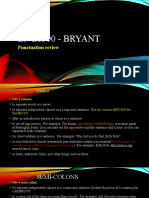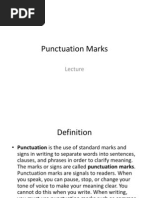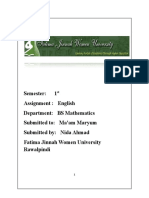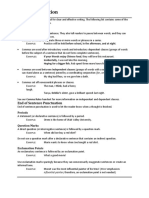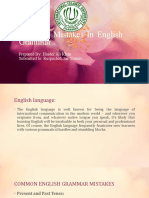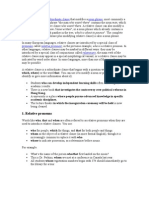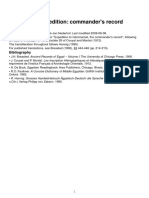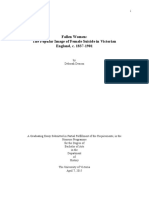The Proper Use of The Apostrophe: Common Rules
The Proper Use of The Apostrophe: Common Rules
Uploaded by
Hassy OpacoCopyright:
Available Formats
The Proper Use of The Apostrophe: Common Rules
The Proper Use of The Apostrophe: Common Rules
Uploaded by
Hassy OpacoOriginal Description:
Original Title
Copyright
Available Formats
Share this document
Did you find this document useful?
Is this content inappropriate?
Copyright:
Available Formats
The Proper Use of The Apostrophe: Common Rules
The Proper Use of The Apostrophe: Common Rules
Uploaded by
Hassy OpacoCopyright:
Available Formats
The proper use of the apostrophe
The apostrophe may be the most abused punctuation mark in the English
language. A quick glance at street signs, advertisements, and store marquees
will demonstrate that almost no one seems to know how to use this mark
properly.
The apostrophe has two, and only two, uses: to show possession and to
indicate the omission of letters or numbers. To further illustrate this point, let us
examine some of the rules that dictate when apostrophes should be used and
where they should be placed in a word.
Common rules
Possessive common nouns are common nouns or pronouns that own other
nouns. Apostrophes are used to indicate this possession in the following ways:
• If the noun does not end in -s (in most cases this means it is singular), add
-’s.
Here are two examples:
The bike's handlebars were bent in the crash.
The boy's sister traveled by bus to meet us.
• If the noun is singular and ends in -s, add -'s, as in the following examples:
My boss's job at the bank was eliminated due to budget cuts.
The class's average grade was impressive.
• If the noun is plural and ends in -s, add only an apostrophe.
The clowns' shoes protruded from the windows of the Volkswagen.
Both bananas' peels had turned brown.
• If the noun is plural and does not end in -s, add -'s.
The children's play received a standing ovation.
The geese's precise formation in the sky impressed the pedestrians.
Some words or phrases are awkward to pronounce when the apostrophe is
added ("geese's precise formation," for example). An author always has the
option of rewriting the sentence to avoid this problem ("The precise formation
of the geese...").
• If multiple nouns jointly own another noun, use an apostrophe only on the
final noun listed. In this sentence, one car belongs to both the man and the
woman.
Example: The man and woman's car was badly damaged.
• If multiple nouns each possess another noun individually, each noun should
have an apostrophe. In this sentence, there are two separate motivations,
each owned by a different person.
Example: The student's and the teacher's motivations were in conflict.
• If a compound noun owns another noun, add the apostrophe only to the last
element.
Example: My sister-in-law's love of shopping knows no limits.
The president-elect's agenda proposed no major policy changes.
• If an indefinite pronoun (a noun that refers to no specific person or thing)
owns a noun, add -'s.
Example: Someone’s car is parked in the loading zone.
Does anybody's key fit this lock?
Proper nouns and apostrophes
Possessive proper nouns are the capitalized names of specific persons,
places, or things. We recommend following the same rules for apostrophe use
on proper nouns as you would on common nouns. For example:
• If the name does not end in -s, add -'s.
Sally's hair was blond and curly.
The Boston Globe's editorial page is popular.
• If the name ends in -s and the pronunciation is not terribly awkward, add -'s.
Robert Burns's poetry is difficult to understand.
Charles Dickens's novels contain an astonishing number of characters.
There are a few exceptions to this rule, of course. One common deviation
occurs when only an apostrophe is added to proper nouns that end in -s: Jesus,
Moses, and Greek names of more than one syllable ending in -es.
In Sunday school, we studied Jesus' nativity and Moses' parting of the
Red Sea.
Sophocles' plays make one wonder what kind of relationship he had with
his parents.
Contractions should not confuse ESL writers
Contractions are shortened versions of words or phrases typically limited
to casual speech or writing. Avoid the use of contractions in formal and
professional writing. When writing a contraction, remember that an apostrophe
marks the place where letters have been omitted. For example:
Don't forget to vote! (Don't is a contraction of do not; the o in not has
been omitted.)
I'm so sick of this cold weather. (I'm is a contraction of I am; the a in am
has been omitted.)
An apostrophe is also used to indicate the omission of the first two digits of a
year or years.
The members of the class of '98 have all gone on to be successful.
The pre-Depression era of the '20s was a time of social change and
material excess.
When NOT to use an apostrophe
The most common apostrophe error is the addition of an apostrophe
where one is not needed. We have found apostrophes in some pretty strange
places. The following are some of the most frequently made errors:
• Do not use an apostrophe in the possessive pronouns whose, ours, yours,
his, hers, its, or theirs.
• Do not use an apostrophe in nouns that are plural but not possessive, such
as CDs, 1000s, or 1960s.
• Do not use an apostrophe in verbs. Apostrophes sometimes show up in
verbs that end in -s, such as marks, sees, or finds.
Some apostrophe mistakes involve the confusion of two words that sound the
same but have different meanings.
• Confusion of its and it's. Its is a possessive pronoun, while it's is a
contraction of it is.
The dog pulled on its leash.
I just realized it's time to go!
• Confusion of your and you're. Your is a possessive pronoun, while you're
is a contraction of you are.
Don't forget your umbrella.
You're the worst dancer I've ever seen.
• Confusion of whose and who's. Whose is a possessive pronoun, while who's
is a contraction of who is.
Whose turn is it to take out the trash?
I wonder who's going to play Hamlet.
Source: https://www.scribendi.com/advice/using_apostrophes.en.html
You might also like
- Grammar WorkshopDocument62 pagesGrammar WorkshopRitwiz ShuklaNo ratings yet
- Theme Error Rules Packet HonorsDocument18 pagesTheme Error Rules Packet Honorsapi-291063790No ratings yet
- Legal Ethics..removal-ExamsDocument2 pagesLegal Ethics..removal-ExamsHassy OpacoNo ratings yet
- Building Brand Architecture Sample Report: HP vs. AppleDocument4 pagesBuilding Brand Architecture Sample Report: HP vs. AppleAyush Gautam100% (1)
- Tripomatic Free City Guide Los Angeles PDFDocument13 pagesTripomatic Free City Guide Los Angeles PDFMICHAEL MAX WILLIAMNo ratings yet
- Assignment Oral Comms.Document5 pagesAssignment Oral Comms.Reymart de VeraNo ratings yet
- Punctuation Sentence Endings: English LanguageDocument8 pagesPunctuation Sentence Endings: English LanguageTraverse FrancisNo ratings yet
- Apostrophe lesson gamesDocument4 pagesApostrophe lesson gamesGrace ManuelNo ratings yet
- Apostrophe Rule-WPS OfficeDocument23 pagesApostrophe Rule-WPS OfficeCindy SuicoNo ratings yet
- Punctuation ReviewDocument9 pagesPunctuation ReviewGlory LuluNo ratings yet
- Punctuation MarksDocument26 pagesPunctuation MarksAtonmai WijunamaiNo ratings yet
- 8th Grade PPT Monday ApostrophesbettyDocument16 pages8th Grade PPT Monday ApostrophesbettyMarjorie ConradeNo ratings yet
- New Microsoft Word DocumentDocument10 pagesNew Microsoft Word Documentesakhan7444No ratings yet
- English Grammar - Articles, Determiners and QuantifiersDocument9 pagesEnglish Grammar - Articles, Determiners and QuantifiersChiby MirikitufuNo ratings yet
- 5 - Lecture 5 - PunctuationDocument38 pages5 - Lecture 5 - PunctuationSaket SinghNo ratings yet
- Attending To GrammarDocument8 pagesAttending To GrammarCarline RomainNo ratings yet
- Articles and DeterminersDocument14 pagesArticles and DeterminersA'isyah Nabihah MokhtarNo ratings yet
- Reader Adjectives AdverbsDocument6 pagesReader Adjectives AdverbsLiu InnNo ratings yet
- The Teacher, A College, A Bit of Honey, That Person, Those People, Whatever Purpose, Either Way, Your ChoiceDocument8 pagesThe Teacher, A College, A Bit of Honey, That Person, Those People, Whatever Purpose, Either Way, Your ChoiceDivya SushmaNo ratings yet
- How To Use Apostrophes: Bangalore Serviced OfficeDocument3 pagesHow To Use Apostrophes: Bangalore Serviced OfficeVivek KumawatNo ratings yet
- Apostrophe: Creating Possessive NounsDocument4 pagesApostrophe: Creating Possessive Nounsjrmr3096No ratings yet
- NidaDocument11 pagesNidaNida AhmedNo ratings yet
- Basic RuleDocument5 pagesBasic RuleWilfred MartinezNo ratings yet
- Punctuation RulesDocument4 pagesPunctuation RulesD. MannNo ratings yet
- Punctuation Rules PDFDocument4 pagesPunctuation Rules PDFAribellaNo ratings yet
- Writing Clear SentencesDocument15 pagesWriting Clear SentencesTariq HassanNo ratings yet
- Basic English HelpingDocument20 pagesBasic English HelpinghassanNo ratings yet
- Figure of Speech All Needed 10Document10 pagesFigure of Speech All Needed 10Sangeeta IndoiNo ratings yet
- Lesson Common Grammar MistakesDocument53 pagesLesson Common Grammar MistakesChristineNo ratings yet
- Punctuation MarksDocument8 pagesPunctuation MarksTriceNo ratings yet
- Common English Grammer MistakesDocument5 pagesCommon English Grammer Mistakessaqib00029No ratings yet
- Quotation Marks: Punctuation Punctuation Is One Component of Writing That People Seldom Think About orDocument10 pagesQuotation Marks: Punctuation Punctuation Is One Component of Writing That People Seldom Think About orMiguel Zay DanielNo ratings yet
- Noun Determiners: Discussant: Camposano, Rhodalyn P Year&Section: BSED-English 1st - ADocument6 pagesNoun Determiners: Discussant: Camposano, Rhodalyn P Year&Section: BSED-English 1st - AGewie Shane Blanco SumayopNo ratings yet
- WK 5 - Grammar and Other UnmentionablesDocument16 pagesWK 5 - Grammar and Other UnmentionablesMatthew LimNo ratings yet
- GrammarDocument6 pagesGrammarjanderson110899No ratings yet
- Possessive S UPDSDocument27 pagesPossessive S UPDSPablo PazNo ratings yet
- 10 Tips For The TOEFL EssayDocument16 pages10 Tips For The TOEFL EssayAbhishek j100% (1)
- Grammar CCC - TheDocument13 pagesGrammar CCC - Theulink leeNo ratings yet
- Common English GrammarDocument11 pagesCommon English Grammarmohamedfouad2222229No ratings yet
- Subject Verb AgreementDocument10 pagesSubject Verb AgreementIshaqueNo ratings yet
- What Are Possessive ApostrophesDocument10 pagesWhat Are Possessive ApostropheswysacadNo ratings yet
- Error #1: Run-On Sentence or Comma SpliceDocument5 pagesError #1: Run-On Sentence or Comma SplicesuthanNo ratings yet
- PerfectYourEnglishCom Writing DDDDocument39 pagesPerfectYourEnglishCom Writing DDDhashamraza74No ratings yet
- Plurals and PossessivesDocument5 pagesPlurals and Possessivesoluwateniola.fadahunsiNo ratings yet
- MechanicsDocument11 pagesMechanicsМария КарпенкоNo ratings yet
- PunctuationDocument4 pagesPunctuationannoyingelephantNo ratings yet
- PunctuationDocument7 pagesPunctuationRobert WalusimbiNo ratings yet
- How To Use English Punctuation CorrectlyDocument7 pagesHow To Use English Punctuation CorrectlyJohnMaryAtepNo ratings yet
- Common Mistakes in English GrammarDocument13 pagesCommon Mistakes in English GrammarMir Hamid100% (1)
- Sentence Endings: When Did Jane Leave For The Market?Document4 pagesSentence Endings: When Did Jane Leave For The Market?nameNo ratings yet
- 4th UbdDocument8 pages4th UbdRuth SameNo ratings yet
- Punctuation ApostropheDocument3 pagesPunctuation Apostrophebacha1494553No ratings yet
- A Narrow EscapeDocument21 pagesA Narrow EscapePrakrutiShah100% (1)
- WC Punctuating With ApostrophesDocument2 pagesWC Punctuating With ApostrophesMian Hussain AhmadNo ratings yet
- Possessives, Conditionals and Other Grammar TopicsDocument103 pagesPossessives, Conditionals and Other Grammar Topicspedro perezNo ratings yet
- Punctuation Brief GuideDocument7 pagesPunctuation Brief GuidetehyitzNo ratings yet
- Ch4 2Document43 pagesCh4 2pnu.talaaNo ratings yet
- Capitalization and PunctuationDocument18 pagesCapitalization and PunctuationMuhammad Arslan QadirNo ratings yet
- Say What You Mean!: Move up the Social and Business Ladder--One Perfect Word After Another.From EverandSay What You Mean!: Move up the Social and Business Ladder--One Perfect Word After Another.No ratings yet
- English / Armenian Dictionary: Words R Us Bilingual Dictionaries, #101From EverandEnglish / Armenian Dictionary: Words R Us Bilingual Dictionaries, #101No ratings yet
- Nurses' Helpline PH Initiative Proposed Guidelines in Handling ReportsDocument2 pagesNurses' Helpline PH Initiative Proposed Guidelines in Handling ReportsHassy OpacoNo ratings yet
- Legal Research ReviewerDocument9 pagesLegal Research ReviewerHassy OpacoNo ratings yet
- 11 01 PDFDocument32 pages11 01 PDFHassy OpacoNo ratings yet
- 18 Additional CasesDocument21 pages18 Additional CasesHassy Opaco100% (1)
- Certificate of Participation: This Certificate Is Awarded ToDocument1 pageCertificate of Participation: This Certificate Is Awarded ToDan Allison Viray CruzNo ratings yet
- When I Was Your Man: Performed by Bruno Mars Transcribed by NohpetsDocument3 pagesWhen I Was Your Man: Performed by Bruno Mars Transcribed by NohpetsMaíra Nascimento0% (1)
- CDMC Presskit 12.11Document3 pagesCDMC Presskit 12.11api-3802582No ratings yet
- Lesbury PDFDocument182 pagesLesbury PDFDale UttersonNo ratings yet
- MasterMind 1 Unit 1 Skills TestDocument2 pagesMasterMind 1 Unit 1 Skills TestFreitaz Ivahn0% (1)
- Four Wise MenDocument4 pagesFour Wise MenkiluNo ratings yet
- Creative Writing For Creative ReadingDocument3 pagesCreative Writing For Creative ReadingAlba García SánchezNo ratings yet
- (Charles Correa) : Post Modern ArchitectureDocument36 pages(Charles Correa) : Post Modern ArchitectureRaviteja NallaNo ratings yet
- Repair Re Line Re BaseDocument66 pagesRepair Re Line Re BaseAbolfazl VaseghiNo ratings yet
- Amago Cuentos de Eva LunaDocument19 pagesAmago Cuentos de Eva Lunaspleenf3282No ratings yet
- Kreu 1 Hammurabi's Law and Mosaic LawDocument4 pagesKreu 1 Hammurabi's Law and Mosaic LawGrupi NjeNo ratings yet
- Winter Solstice Article For CFWN Dec2015Document4 pagesWinter Solstice Article For CFWN Dec2015antara1111No ratings yet
- Proverbs: Advice Is Found On The Pillow," He/she Means That It Might Not Be Good To Worry About Your ProblemDocument19 pagesProverbs: Advice Is Found On The Pillow," He/she Means That It Might Not Be Good To Worry About Your ProblemS GuhaNo ratings yet
- Warm Ups That WorkDocument28 pagesWarm Ups That WorkIligancitysda Centralchurch Youthchoir71% (7)
- Resume 12-8-13Document2 pagesResume 12-8-13api-242607377No ratings yet
- MainarDocument7 pagesMainarCheol-ah Ki100% (1)
- Actual Test 23Document7 pagesActual Test 23Thúy Mai HồNo ratings yet
- Hammamat Expedition: Commander's Record: Nederhof - EnglishDocument4 pagesHammamat Expedition: Commander's Record: Nederhof - EnglishNabil RoufailNo ratings yet
- Impression Materials and Impression Techniques: ClassificationDocument7 pagesImpression Materials and Impression Techniques: ClassificationruchikaNo ratings yet
- R3 The Black Libram of NartarusDocument37 pagesR3 The Black Libram of Nartarusqxi360100% (6)
- Lesson PlanDocument5 pagesLesson Plansai10111989No ratings yet
- Infiltration Embedding ReviewerDocument4 pagesInfiltration Embedding ReviewerJoey Magno50% (4)
- Fallen WomanDocument43 pagesFallen WomanHéctor Montes Alonso100% (1)
- Reading Drawing BuildingDocument38 pagesReading Drawing Buildingmrafiq9002No ratings yet
- BrahmayagyamDocument7 pagesBrahmayagyamvikramgopal67% (3)
- Heros Journey The Sword From The Stone - 1Document49 pagesHeros Journey The Sword From The Stone - 1nextcrisNo ratings yet
- True WorshipDocument1 pageTrue WorshipLester EvangelistaNo ratings yet
- Amara Kosha Kannada GKVK Bangalore LibraryDocument446 pagesAmara Kosha Kannada GKVK Bangalore Libraryananthakrishna100% (1)









